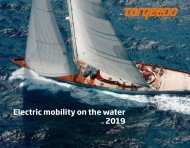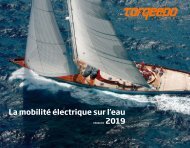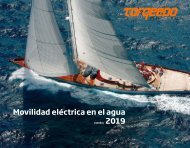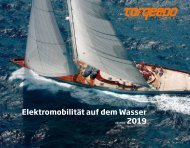Torqeedo Catalogue 2019 - English
For more than a decade, Torqeedo has led the way in electric mobility on the water. Creating the products for cleaner, safer, easier and more sustainable electric boating remains Torqeedo’s focus for 2019.
For more than a decade, Torqeedo has led the way in electric mobility on the water. Creating the products for cleaner, safer, easier and more sustainable electric boating remains Torqeedo’s focus for 2019.
You also want an ePaper? Increase the reach of your titles
YUMPU automatically turns print PDFs into web optimized ePapers that Google loves.
New mobility<br />
Digitalisation, electrification and autonomous vehicles are changing how we<br />
get around, and <strong>Torqeedo</strong> is bringing new mobility onto the water<br />
Moving smarter<br />
Life is movement. We are constantly on the go –<br />
travelling to work, meeting friends, making business<br />
trips around the world or sailing for leisure. But<br />
how we move people and products and with that<br />
our entire mobility culture, is changing – and that is<br />
a good thing.<br />
People used to travel from A to B on foot or by car,<br />
bike or train. Today, we navigate the ever-morecomplex<br />
urban infrastructure with our smartphones,<br />
changing from rent-a-bike to Uber pool to<br />
subway travel in an instant. Digitalisation and connectivity<br />
are driving a mobility revolution not seen<br />
since the advent of combustion engines.<br />
Freight transport is also reaping the benefits of intelligent<br />
connectivity and new digital products – for<br />
example, by accurately determining free transport<br />
capacities and automatically allocating them to<br />
suitable cargoes, thus avoiding empty runs. Making<br />
mobility cleaner and more efficient saves time,<br />
money and reduces our climate impact.<br />
E-mobility on the water<br />
These new, smart and interconnected mobility services<br />
are now extending onto the water. Many old<br />
canals and rivers that had been covered by concrete<br />
for decades are being reopened and integrated into<br />
the public transport network in order to ease the<br />
burden on road and rail infrastructure.<br />
In the Chinese city of Suzhou, a fleet of nearly 200<br />
working boats is operating with <strong>Torqeedo</strong> electric<br />
motors to remove rubbish and prevent plastic pollution<br />
from reaching the ocean. Electric ferries and<br />
catamarans are covering roofs and sunlit surfaces<br />
with solar panels to generate energy and reduce<br />
pollution, or even go completely emission-free.<br />
Electric ferries are contributing to cleaner air in<br />
metropolitan areas and lowering the carbon footprint<br />
of on-water transport.<br />
A new operating system<br />
The mobility revolution goes beyond exchanging<br />
motors; the whole operational system is being<br />
reprogrammed. Amsterdam is the first large city<br />
to start trials of autonomous transport boats for<br />
goods distribution. Engineers are currently livetesting<br />
a <strong>Torqeedo</strong>-powered autonomous electric<br />
ferry for crossing a canal in Trondheim, Norway.<br />
Soon we will see autonomous ferries or water taxis<br />
on urban canals or rivers that will be ordered by<br />
smartphone. As 21st-century technology shouldn’t<br />
be powered by 20th-century engines, electric motors<br />
are the propulsion technology of choice for this<br />
new application field.<br />
Smart, connected electric mobility means the<br />
world’s great cities can improve air and water quality,<br />
protect the climate and simultaneously improve<br />
their citizens’ quality of life. We’re proud to be part<br />
of this global transformation.<br />
10







